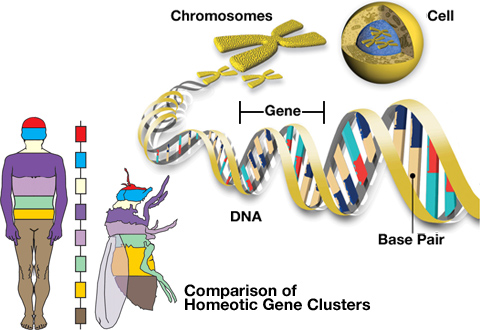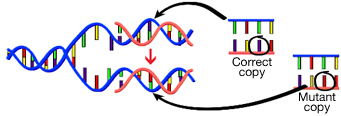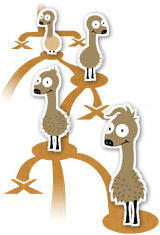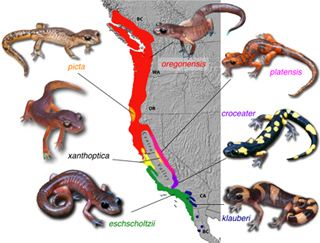

All embryos start off as a nearly identical cluster of cells and it is the DNA which dictates how an organism is constructed during its development. DNA acts sort of like blueprints for the cells and the slightest changes in the DNA results in a change of the final structure. Each bar on the twisted ladder of DNA is called a "base pair" and consists of 2 of the 4 bases; Adenine, Thymine, Guanine, & Cytosine. A pattern of base pairs is called a gene and the complete collection of these patterns is called the genome.

When a living organism (including us humans) reproduces it makes a copy of its DNA to pass on to its offspring, so that offspring's cells has a set of blueprints to base its development on. Our DNA blueprints are a copy of our parents' DNA blueprints, but not a perfect copy. Every single time DNA is copied during reproduction errors occur in the copying process leaving slight changes known as "mutations." Such mutations commonly range in size from a single base pair to a large segment of a chromosome. Most of these changes, but not all, are so slight that they have no effect on appearance or bodily functions and go completely unnoticed. As generations pass these changes add up causing the current DNA to differ more and more each generation from the ancestral set of DNA.

Imagine that an architect creates a blueprint then gives a copy of the blueprint to a second architect who makes slight modification to it. Now imagine that the slightly modified blueprint gets passed on to 1,000 different architects who each make a slight modification before passing it on to the next. Obviously a structure based off of the original blueprint is going to appear very different from a structure based off of the blueprint that contains 1,001 modifications.



Life's complexity is NOT the result of random chance. It appears designed because it was designed, just not by a conscious designer. The designer is nature and the designing process is known as Natural Selection which weeds out harmful mutations and maintains beneficial ones. Nature can be brutal and only the DNA of those who survive and reproduce gets passed on and built upon. 95-99% of all species that have lived on earth were weeded out by nature and have gone extinct. After enough filtering Natural Selection produces fine tuned results that appear utterly impossible at a first glance.
Since nature is obviously not a conscious force evolution is not goal orientated. There is no foresight and no targeted outcome. Because of this, evolution is not necessarily progressive and the improving of one trait may lead to the hindering of another. The ability to walk upright came at the cost of an altered birth canal that, before modern medicine, made giving birth result in the death of 1 out of every 5 women. Since the gain was great than the loss when our ancestors first walked upright Natural Selection treated it as a favorable improvement.

Why would Natural Selection favor genes for brightly colored feathers that predators could spot a mile away? The answer is sex. Brightly colored birds are all male and female birds prefer males with bright colors and flashy tails. Thus having brightly colored feathers increases a male bird's chances of having sex and passing on his genes.
Giraffes did not obtain long necks to eat from tall trees. Just as modern giraffes, ancient giraffes used their necks in foreplay and while battling for a mate so those with the genes for longer necks were more likely to mate and reproduce. Sexual selection is how giraffes obtained their long necks and it is those long necks that later allowed them to survive, unlike most species of Giraffidae, when plants and bushes became scarce in Africa.

First off, you need to understand what a species actually is. Species are not classified based on physical apparences, they are classified on the genetic level. A species is a group of animals that can regularly produce fertile young while interbreeding. Wether or not two animals can interbreed is determined by genetics. The greater the amount of differences in the genes the less compatible two animals are.
Poodles and cocker spaniels are different breeds of the same species, Canis lupus. They are genetically similar and can reproduce fertile young. Horses and donkeys are separate species because they are less similar genetically causing their offsprings, mules, to usually be infertile. All male mules and most female mules are infertile.
In simplest terms: If two animals cannot regularly produce fertile young, they are different species.

New species are created when a common gene pool is simply set on different paths. When members of a species become reproductively isolated from the rest of the group, typically due to geographical barriers, the separate groups start gaining a separate collection of mutations through the generations.
Take for example the ensatina salamanders of California.
As a population of e. oregonesis salamanders headed south the population became split by the San Joaquin Valley in central California. As the two groups gradually headed south they each acquired a different set of genetic mutations each generation. By the time the two groups of salamander reunited in the southernmost part of California they each became two separate species, e. eschscholtzii & e. klauberi. Because their gene pools were set on two different paths for so long they acquired enough genetic differences to prevent them from being able to interbreed and reproduce fertile young with one another

Structural features that may look dramatically different on the outside tend to be the result of very slight changes on the genetic level. New physical structures do not require new genes, they are formed by reusing old genes in new ways. Scales and feathers are produced from the same genes and during development they both start off as tissue swellings called placodes. Also, mice and flies use use the same gene, "the Eyeless Gene," for the creation of their eyes. In an experiment the Eyeless Gene of a fruit fly embryo was replaced with the Eyeless Gene from a mouse's DNA and the fruit fly was still able to grow compound eyes.
Using old genes in new ways
For decades, scientists have understood that the process of evolution involves changes in protein-coding genes: mutations can change a gene's instructions, making it code for a protein with a slightly different function. The modification of gene switches provides another avenue for evolutionary change. Often just a few base pairs long, switches regulate the timing, location, and level of protein expression - without affecting the protein itself. Small changes to switches can produce dramatic outcomes.

In the fly seen here, a genetic mutation caused a gene switch to switch off the Ubx gene during the larval stage, in the 3rd thoracic segment. This segment normally produces halteres (tiny balancers), but instead a second set of wings were produced. With the switch of a single gene, from on to off, during the development of a fly's 3rd thoracic segment that 3rd segment became an additional second thoracic segment.
This demonstrates how the mere timing of gene switch can result in dramatical structural differences.












 In the fly seen here, a genetic mutation caused a gene switch to switch off the Ubx gene during the larval stage, in the 3rd thoracic segment. This segment normally produces halteres (tiny balancers), but instead a second set of wings were produced. With the switch of a single gene, from on to off, during the development of a fly's 3rd thoracic segment that 3rd segment became an additional second thoracic segment. This demonstrates how the mere timing of gene switch can result in dramatical structural differences.
In the fly seen here, a genetic mutation caused a gene switch to switch off the Ubx gene during the larval stage, in the 3rd thoracic segment. This segment normally produces halteres (tiny balancers), but instead a second set of wings were produced. With the switch of a single gene, from on to off, during the development of a fly's 3rd thoracic segment that 3rd segment became an additional second thoracic segment. This demonstrates how the mere timing of gene switch can result in dramatical structural differences.
